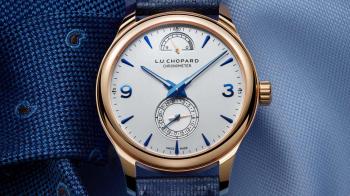1993 was the year Chopard embarked upon the creation of haute horlogerie movements. In 1996, the first model was launched from the company’s Fleurier premises (not quite yet a manufacture): this was the 1.96 micro-rotor calibre that equipped the first modern L.U.C watch, the 1860. In 2000, as mechanical watches were beginning to take off, the brand launched its second calibre, the manually wound 1.98 (which would later be renamed the 98.01). This time Chopard focused on a new feature, the long power reserve. With its four barrels stacked two by two in series, the calibre can achieve an autonomy of 216 hours, or 9 days. This was an innovative solution at the time, as it overcame the main problem afflicting watches with a particularly long power reserve – a lack of precision.

By the end of the 90s, 8-day movements were old technology: they were powerful when fully wound, but grew weaker as the stored energy was depleted, which affected their timekeeping precision. The 1.98 calibre releases its power more smoothly, which is why it has been chronometer certified from the very beginning. And not much else has changed in the intervening 18 years. The movement is the same, except that it is now available in several different versions, including one with a tourbillon and a perpetual calendar. It’s very easy to spot: currently, it’s the only movement on the market that has both a power reserve at 12 o’clock and a date with concentric small seconds register at 6 o’clock.

How can we explain its extraordinary longevity? The first reason lies in the nature of watchmaking itself. Unlike a car engine or a computer operating system, watch movements don’t even go into production unless they have an expected lifetime of at least twenty to thirty years. But we must also factor in one of Chopard’s essential operating principles: the brand is owned and managed by one family; its watchmaking activities are overseen by one man – Karl-Friedrich Scheufele – whose decisions are always prudent and well-considered. Some years ago he called upon the assistance of a Fleurier neighbour, a modest man by the name of Michel Parmigiani. It was he who created the original L.U.C calibres, and a team set up at the same time was responsible for transforming those original ideas into a product that would stand the test of time.

The first version of the Quattro was launched in 2000. With its 38 mm gold case, guilloché dial and bevelled arrow markers, it was as quiet and unassuming as the company president. A few years later, on the strength of a widespread enthusiasm for larger diameters and more exuberant designs, the Quattro was updated in line with Chopard’s new design imperatives. The hours were marked out with generous Arabic numerals. The figures on the power reserve indication increased in size as they went from 0 to 8 days, and there were more asymmetrical numerals on the date register at 6 o’clock. A guilloché motif radiated out from 12 o’clock to fill the dial. 2015 saw another change of direction, back towards more classical codes. The chapter ring reverted to slim and elegant Roman numerals, the indications on the power reserve, date and seconds registers were replaced with a slender black minimalist type, and the diameter was adjusted to 43 mm. This freed up more space for the power reserve, and its hand consequently changed position.

In the latest development to date, the Quattro was given a facelift for Baselworld 2018, and now features just two numerals: 3 and 9. A fan-shaped power reserve, a return to bevelled markers, a vertically brushed dial and a blue / grey / pink colour scheme provide some interesting touches on this more informal new reference. But some features have not changed. First, the chronometer certification, which is obligatory for all L.U.C watches. Then there is the high quality of the hand-finished movement with its swan-neck regulator. Since 2015, the Geneva hallmark has also been standard. This all goes hand-in-hand with the exclusive use of precious metals. The Quattro has only ever been available in gold, with just one reference in platinum.








